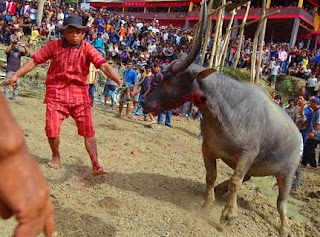The real name of Toraja was Tondok Lepongan Bulan Tana Matarik Allo which means “ a country of one administration, religion and culture as rounds as the moon (bulan) and the sun (allo).”
The Toraja came into existence in the 17th century, coined by the Bugis of Luwu from To-ri-ja meaning to (people), ri (from), aja (inner west). Another version says it means “men of the mountains.”
According to same sources, the early Torajans migrated from southeast Asia, probably
Somewhere in the southwest and up the Sa’dan river, setting in what is now the Enrekang area. As new waves of migration occurred, the earlier groups were forced to retreat into the mountains where they wandered under the leadership o Puang Pararrak. There were 40 arruan (groups), coordinated under a Tangdino. Then came the Tomanurun, meaning people descended from heaven, led by Tamborolangi’ who introduced new agricultural method, the caste system and the practice of the seath rituals.
The early settlers coming in boats set the patern of the prowshaped roofs of the tongkonan houses as they converted thir boats into houses, having no place to live.
A legend tells of the tomanurun, who were celestial beings and descended on the mountain peaks. One of them, Tomanurun Tamborolangi’,lived in kandoro. He had son, Puang Sanda Boro who ruled the southern part of Padang di Puangngi and two sons. One of them, Lakipadada, went in search of eternal life and arrived in Gowa (the mighty kingdom in the south) and so impressed the king that he was given the princes in marriage. They had three sons who grew up to each rule Gowa, Toraja and Luwu. They were known as the Tallu Botto (top Three).
Legend and actual history seem to be interwoven as the royal regalia kept in Kaero Sangalla are believed to belong to Patta Labantan, the first son of Lakipadada and Karaeng Tarallolo, who ruled Toraja.
There seemed to be contacts between Toraja and java in the 15thth century, war broke out with Bone. Toraja was defeted by Aru Palaka of Bone but five years later the Torajans resisted and defeated the intruders. Islam was introduced by coffe and slave traders, but only a small part in the south, Duri, was converted. century, through traders. Also with the Bugis who sold Indian cloth, Dutch coins and Porcelain. However , there was always some friction and in the 17
Several years later a peace treaty was signed.
The Dutch first arrived in Toraja in 1905 from the north, during a period of internal conflict. Under Pong Tiku, the Torajans fought a losing battle against the superior forces of the Dutch and two years later Toraja fell under the rule of the
Not long sfter, in 1913, protestant missionaries arrived, followea by the Catholics in 1937. Between the Dutch and Dutch colonial government and the Missionary Alliance of the Dutch Reformed Church, many changes were brought about in education, traditional life and political structure.
Toraja has gone through several administrative changes, and is now administered by a bupati (district head) posted in Makale who reports to the governor of


No comments:
Post a Comment